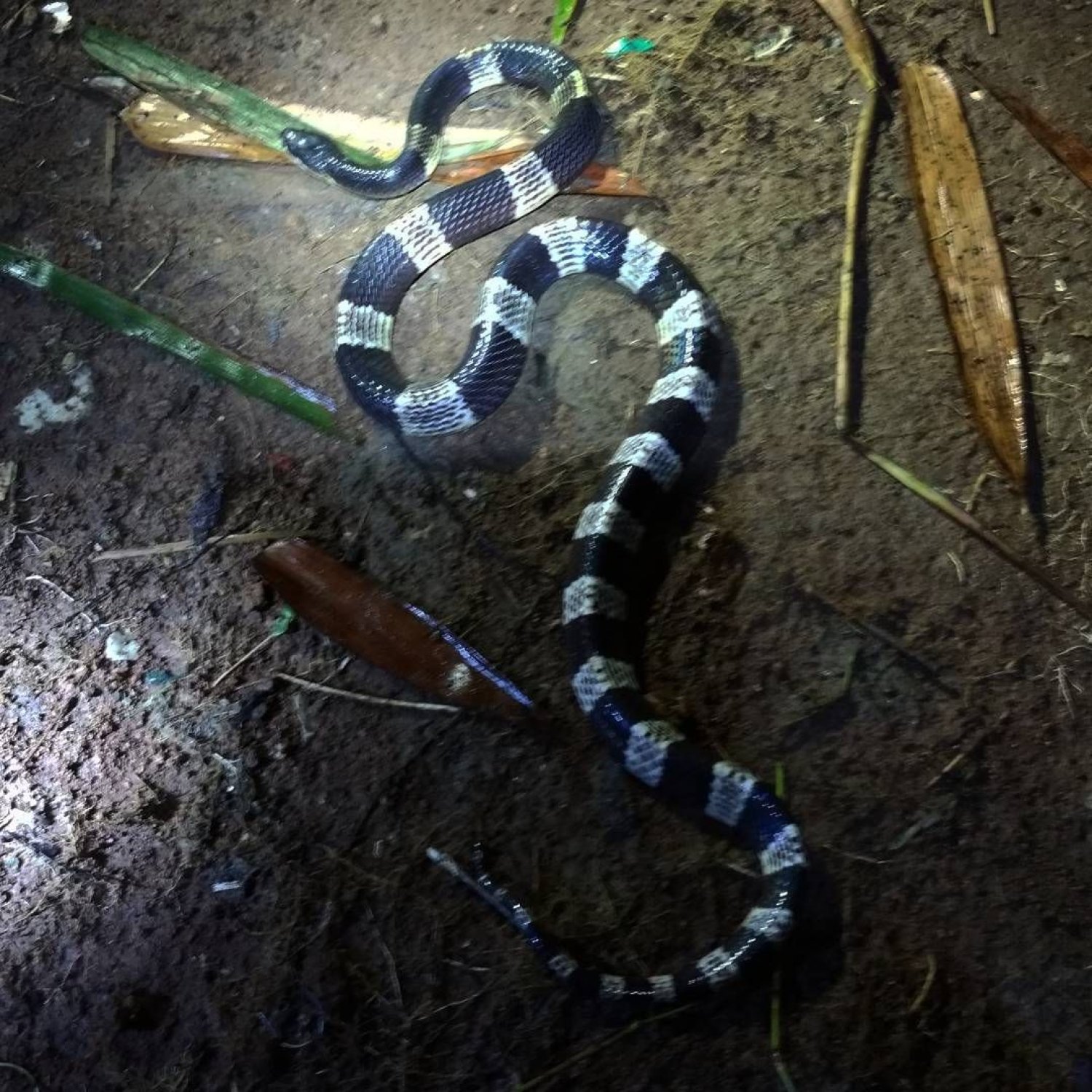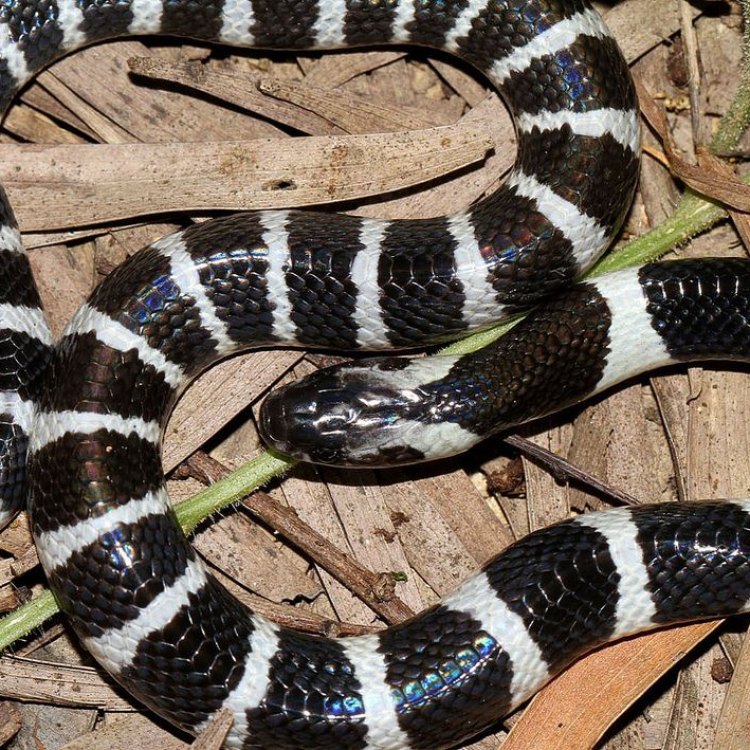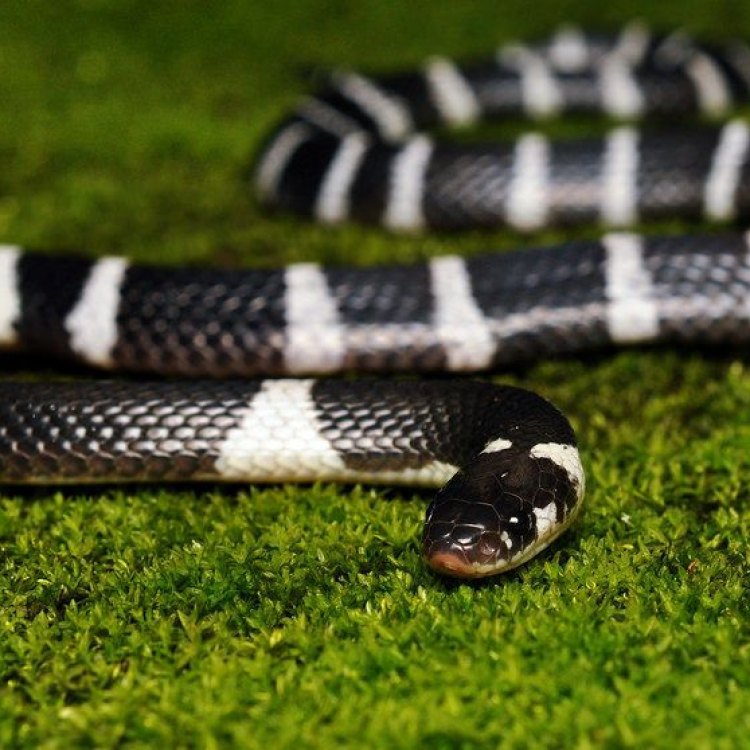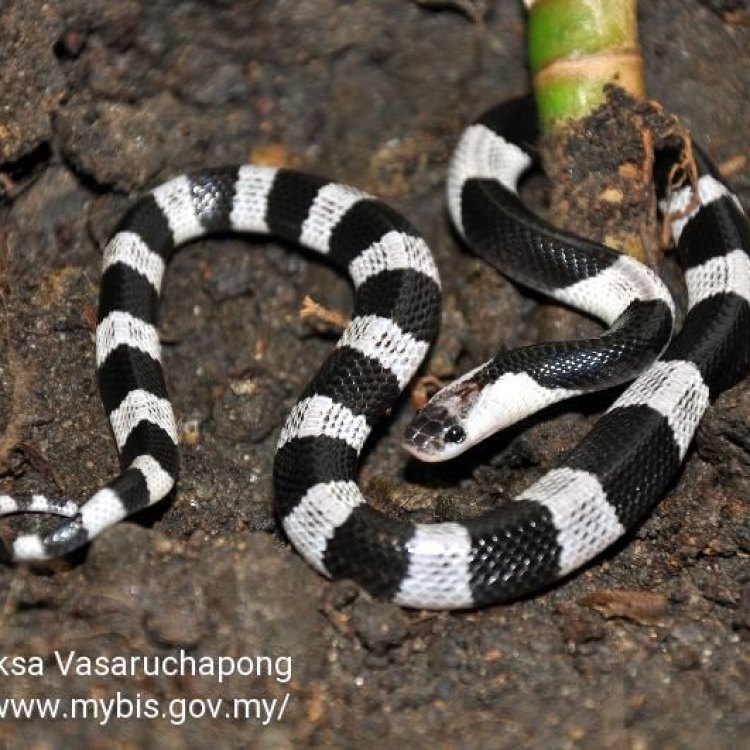
Malayan Krait
1.2 - 1.5 meters
The Malayan Krait, found in Southeast Asia, is a deadly snake with a slender and elongated body that can grow up to 1.2-1.5 meters in length. Belonging to the Elapidae family, it is known for its highly venomous bite. They are mainly found in coastal regions and islands, making them a common threat to those living in these areas. Remember to always be cautious when encountering any wild animal.
Animal Details Summary:
Common Name: Malayan Krait
Kingdom: Animalia
Habitat: Tropical rainforests, plantations, farmlands
The Beautiful and Deadly Malayan Krait: A Fascinating Reptile of Southeast Asia
The world of reptiles is diverse and filled with fascinating creatures, and one such creature is the Malayan Krait. This strikingly beautiful and deadly snake is a resident of the tropical rainforests, plantations, and farmlands of Southeast Asia, with its stronghold being Malaysia. Scientifically known as Bungarus candidus, the Malayan Krait belongs to the Animalia kingdom, Chordata phylum, Reptilia class, Squamata order, and Elapidae family. Its unique physical characteristics, geographical distribution, and feeding habits make it a must-know for any nature enthusiast Malayan Krait.A Unique Coloration and Body Shape
The Malayan Krait is easily recognizable by its black and white stripes, which run along its entire body. This striking coloration is known as aposematic coloration, which serves as a warning to potential predators of its deadly venom. The stripes are evenly spaced and give the snake a sleek and elegant appearance. However, there is no uniformity in the stripe pattern, and every individual can have a slightly different pattern. The black and white stripes are a perfect example of nature's beauty and its way of protecting its own.In addition to its unique coloration, the Malayan Krait is also known for its slender and elongated body shape. With a length ranging from 1.2 to 1.5 meters, it is considered a medium-sized snake Mastador. Its body is cylindrical and tapers towards the tail, giving it a streamlined appearance. With its body built for speed and agility, the Malayan Krait is well-adapted to its habitat and an excellent hunter.
A Habitat in the Tropics
The Malayan Krait is a resident of Southeast Asia, with its highest concentration found in Malaysia. However, it can also be found in other countries such as Thailand, Singapore, and Indonesia. Its preferred habitats are tropical rainforests, plantations, and farmlands. These areas provide ideal cover and an abundant supply of prey for the snake.Due to its excellent adaptability, the Malayan Krait has also been spotted in urban areas, especially in coastal regions and islands. This has led to an increase in human-snake encounters, as the snake's preferred food source, rodents, can also be found in urban areas. However, it is important to note that the Malayan Krait is a shy and non-aggressive snake, and will only attack if it feels threatened or cornered.
A Carnivore at Heart
The Malayan Krait has a strict carnivorous diet, feeding mainly on other snakes, lizards, and rodents. Due to its venom, it is able to hunt and kill prey much larger than itself. The snake's venom is a potent neurotoxin, which paralyzes its prey and causes respiratory failure, ultimately leading to death. This highly specialized feeding method is crucial for the survival of the Malayan Krait and helps maintain a balance in its ecosystem.A Majestic Creature of Southeast Asia
The Malayan Krait is not just an ordinary snake but a majestic creature of Southeast Asia. Its presence in the region is not simply a coincidence, as it plays an important role in the tropical ecosystem. As a top predator, it helps regulate the population of small mammals, keeping their numbers in check and preventing overgrazing of vegetation.In addition, the Malayan Krait has also been part of the traditional medicine and culture of the local indigenous communities. Its venom has been used for centuries to treat various ailments, such as paralysis and epilepsy. However, it is important to note that the use of its venom is highly regulated and should only be administered by trained professionals.
Conservation Efforts and Threats
The Malayan Krait is listed as a vulnerable species on the International Union for Conservation of Nature (IUCN) Red List. Its population has been steadily decreasing due to habitat loss, encroachment by humans, and indiscriminate killing. As a snake that is highly misunderstood and feared, the Malayan Krait often falls prey to human persecution. Many are killed due to the false belief that they are aggressive and will attack without provocation.To preserve this beautiful and essential reptile, conservation efforts are being taken by various organizations and governments. Awareness campaigns are being conducted to educate the public on the importance of the Malayan Krait and its role in the ecosystem. Efforts are also being made to conserve its natural habitat and protect it from poaching and illegal trade.
A Solo Life
The Malayan Krait is a solitary animal and is only known to come together during mating season. The breeding season for this species is during the rainy season, and the female will lay between 10-20 eggs in a secluded nest. The eggs are left on their own, and the young snakes will have to fend for themselves from the moment they hatch.In Conclusion
The Malayan Krait is a fascinating reptile that has captivated the hearts of many nature enthusiasts. Its unique coloration, body shape, and hunting abilities make it a remarkable creature of Southeast Asia. However, with its population declining due to human activity, it is our responsibility to protect and conserve this beautiful snake. The Malayan Krait is a vital part of the ecosystem, and its survival is crucial for the balance of nature. So let us appreciate and admire this magnificent reptile from a safe distance and work towards ensuring its existence for future generations.

Malayan Krait
Animal Details Malayan Krait - Scientific Name: Bungarus candidus
- Category: Animals M
- Scientific Name: Bungarus candidus
- Common Name: Malayan Krait
- Kingdom: Animalia
- Phylum: Chordata
- Class: Reptilia
- Order: Squamata
- Family: Elapidae
- Habitat: Tropical rainforests, plantations, farmlands
- Feeding Method: Carnivorous
- Geographical Distribution: Southeast Asia
- Country of Origin: Malaysia
- Location: Coastal regions and islands of Southeast Asia
- Animal Coloration: Black and white stripes
- Body Shape: Slender and elongated
- Length: 1.2 - 1.5 meters

Malayan Krait
- Adult Size: 1.2 - 1.5 meters
- Average Lifespan: 10-15 years
- Reproduction: Sexual
- Reproductive Behavior: Oviparous
- Sound or Call: Hissing
- Migration Pattern: Non-migratory
- Social Groups: Solitary
- Behavior: Nocturnal
- Threats: Habitat loss, poaching, snakebite incidents
- Conservation Status: Least Concern
- Impact on Ecosystem: Maintains balance by controlling rodent population
- Human Use: Venom for medical research
- Distinctive Features: Black and white banded body
- Interesting Facts: Malayan Kraits are highly venomous and their bites can be deadly.
- Predator: Birds of prey, larger snakes

Bungarus candidus
The Deadly Elegance of the Malayan Krait
If you're walking through the dense forests of Southeast Asia, you may come across a sleek and strikingly beautiful snake, with a unique black and white banded body. This is the Malayan Krait, scientifically known as Bungarus Candidus, one of the most venomous snakes in the world. From its distinctive appearance to its fascinating behaviors, the Malayan Krait has captured the attention of researchers and snake enthusiasts alike. Let's delve deeper into the intriguing world of this deadly yet elegant creature PeaceOfAnimals.Com.Appearance and Size
The Malayan Krait is a slender and elongated snake, with a typical length ranging from 1.2 to 1.5 meters. It has a distinctive black and white banded body, with 11-17 dark bands and 13-19 white bands. These bands run across the entire length of the snake, giving it a unique and striking appearance. The head of the Malayan Krait is small and thin, with a rounded snout and small black eyes.As a member of the Elapidae family, the Malayan Krait has short fangs and a potent neurotoxic venom. However, unlike its close relatives, such as the Black Mamba, it does not possess the ability to expand its hood. Instead, it relies on its cryptic coloration to blend in with its surroundings and avoid predators Muskellunge.
Lifespan and Reproduction
The Malayan Krait has an average lifespan of 10-15 years, in captivity. However, the exact lifespan in the wild is difficult to determine, as they are solitary and highly elusive creatures. They prefer to live in secluded areas and only come out at night, making it challenging for researchers to study them in their natural habitat.Like most snake species, the Malayan Krait reproduces sexually and is oviparous, meaning it lays eggs. After mating, the female Krait will lay a clutch of 6-20 eggs, which she will incubate for about 2-3 months. Interestingly, the offspring of the Malayan Krait do not require parental care and are independent from the moment they hatch.
Behavior and Habitat
Being nocturnal, the Malayan Krait is most active at night and spends the daytime hours hidden in leaf litter, crevices, or burrows made by small mammals. They are solitary animals and are not typically seen in social groups. They are also known to be shy and will usually only show aggression when threatened.The Malayan Krait is a non-migratory species, meaning it stays in a specific area rather than traveling long distances. This is due to its reliance on a specific environment, and any change or disturbance in its habitat can have a significant impact on its survival.
Threats and Conservation Status
Unfortunately, like many other snake species, the Malayan Krait is facing multiple threats that have led to a decline in its population. Its primary threat is habitat loss due to deforestation and human activities such as logging and agriculture. As a result, their natural habitats are becoming fragmented, and the species is losing its breeding and feeding grounds.Poaching is also a major concern, as the Malayan Krait's venom is highly sought after for medicinal use. Despite regulations and laws, black market trade of venomous snakes continues to pose a significant threat to their population. Additionally, snakebite incidents caused by the Malayan Krait have also resulted in fatalities, adding to the negative perception of this species.
However, according to the International Union for Conservation of Nature (IUCN), the Malayan Krait is currently listed as least concern on the Red List of Threatened Species. This is mainly due to its widespread distribution across Southeast Asia and a lack of concrete data on population decline. Nevertheless, efforts are being made to protect and conserve this unique species, and it is crucial to raise awareness about their importance in maintaining the balance of the ecosystem.
Role in the Ecosystem
As a nocturnal predator, the Malayan Krait plays a significant role in keeping the rodent population in check. As a result, this helps to maintain the balance of the ecosystem and prevent the spread of diseases carried by rodents. Furthermore, they also provide a food source for larger snakes and birds of prey, contributing to the food chain in the forest.Human Use and Research
Despite their potentially deadly bite, the Malayan Krait is an important species for medical research. Their venom contains neurotoxins that can be used for the development of new painkillers and antivenoms, saving thousands of lives. However, to obtain venom from these snakes, they must be captured, which can be detrimental to their survival in the wild.Moreover, the growing interest in snake keeping has resulted in a rise in captive-bred Malayan Kraits, which is a positive step in reducing the demand for wild-caught individuals. While some keep them as pets, others use their venom for medical research, making them a valuable species to humans for both conservation and scientific purposes.
Interesting Facts
Malayan Kraits are highly venomous, and their bites can be deadly. They are known to have a high venom yield and a bite from one can be fatal within a few hours if left untreated.Their venom contains 8 different types of neurotoxins, making it one of the most potent in the world. These toxins attack the nervous system, causing paralysis and respiratory failure, which can lead to death.
Despite their lethal venom and fearsome reputation, the Malayan Krait is a shy and non-aggressive species. They will only bite when provoked or threatened.
The Malayan Krait is known to be the most common snake species involved in snakebite incidents in Southeast Asia. This highlights the need for proper education and awareness to prevent people from getting bitten and to protect this species from unnecessary harm.
In Conclusion
The Malayan Krait is a strikingly beautiful and deadly species, with a crucial role in maintaining the balance of the ecosystem. With their unique black and white banded body, they have captured the fascination of people worldwide. However, as with many other snake species, their survival is threatened by various human activities. It is essential to educate and raise awareness about the importance of conserving this species and their environment to ensure their continued existence in the wild. So, the next time you come across a Malayan Krait, remember its deadly elegance and the role it plays in our ecosystem.

The Beautiful and Deadly Malayan Krait: A Fascinating Reptile of Southeast Asia
Disclaimer: The content provided is for informational purposes only. We cannot guarantee the accuracy of the information on this page 100%. All information provided here may change without prior notice.












